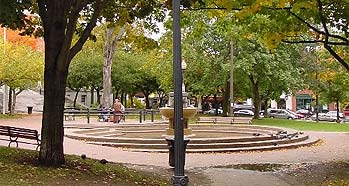Burlington’s drug problem haunts City Hall Park

By Bruce Parker | For Vermont Watchdog
BURLINGTON, Vt. — Vermont’s drug problem has grown so severe that Burlington City Council members say they’re afraid to walk through City Hall Park.
PARK WITH PROBLEMS: Burlington’s City Hall Park is awash with problems.
So far, they are tackling the issue with more rehab and better landscape design.
“We have a park on the back side of City Hall — City Hall Park it’s called — and there’s not one city councilor who walks out the back door through that park to their car because they’re afraid for their safety,” said Paul Decelles, a Burlington city councilman.
City Hall Park, which sprawls one city block behind City Hall, has become a popular haunt for panhandlers, drifters and drug dealers.
To some, the park stands as a symbol of the failing policies that have brought the state’s drug problem to the doorstep of the city’s elected officials. Locals who live and work in the area say the situation is out of hand.
“In the summer it gets pretty nasty,” said Julia Smith, a retail sales associate at a nearby boutique, who regularly walks her dog through the park.
“I see people passed out all day there. I’m sure there are drugs, too. I’ve been approached about that kind of thing in the past. So there’s that, and then there’s homelessness, which unfortunately goes hand in hand.”
The problem in Burlington is getting worse, Decelles said.
“We have a very serious opiate problem,” Decelles told Watchdog.org. “We have people breaking into homes in the middle of the day. There’s no more, ‘I’m going to break into your house in the middle of the night, when it’s quiet and dark’— people are becoming very brash, stealing anything they can get their hands on.”
The issue has garnered national attention with Vermont recently identified as the state with the biggest drug problem. So far, politicians have proposed little more than taxpayer-funded rehab for offenders.
Gov. Peter Shumlin, in his State of the State address, pledged to fix the issue by throwing millions of new dollars at drug recovery and rehabilitation programs. The Legislature’s strategy has been to substitute drug treatment for jail time.
Last week, U.S. Sen. Patrick Leahy highlighted Vermont’s heroin epidemic in a Senate Judiciary Committee field hearing in Rutland, and he touted Vermont’s response as a possible model for the nation.
With Vermont’s status as the top drug state, however, a question arises as to whether soft solutions are strong enough to solve the problem.
“The waiting list for meth addicts is like 900 people long to get rehabilitation,” Decelles said. “We have a very serious issue.”
City Council’s new plan to give a multi-million dollar makeover to City Hall Park relies on even more soft measures, not a strong police presence.
Burlington Police Chief Michael Schirling explained the department’s approach to cleaning up the park.
“From the safety perspective, any time you look at public spaces in the 21st century, one of the things you look at is what’s called crime prevention through environmental design,” Schirling told Watchdog.
Schirling said the objective is to design the park in a way that attracts positive activity and minimizes secluded spaces.
“For example, if you put up a fence at the corner at the park that no one can see through, you may inadvertently create a safety hazard, because you have a dark corner that isn’t subject to other people walking by being able to see what’s happening.”
The police chief said crime prevention through environmental design entails using graffiti-proof surfaces, strategic lighting and even smart use of plants and bushes.
“If you look at the park today, the tree canopy is very low, which creates darkness, which makes people feel uncomfortable,” he said.
“You want to put plantings that people are not going to want to walk through, so as to pee in the bushes; or if you find somebody with a drug habit, you don’t want them doing drugs on the other side of that planting, so you use thorny plantings.”
Above all, Schirling said, park safety is about attracting positive events and crowds that can naturally displace negative activities.
“Always have something going on at the park that’s positive, whether that’s adding vending, so people can buy food there, or outdoor performance spaces, where you can do outdoor dances, small orchestras, or art events. As a result you don’t have negative activity going on.”
It remains to be seen whether crime prevention through environmental design can tackle Burlington’s real problems, which Schirling admits are serious.
“Heroin is epidemic in the nation, and opiates are epidemic in the nation. We have the problem here in Vermont … you also get people drinking in public, and you get altercations — what we call ‘private drama in public spaces.’ You get low-level drug dealing, when there’s nobody around.”
Schirling isn’t opposed to policing criminal activity, but the City Council and some residents are averse to cracking down on panhandlers and stragglers.
“We’ve had very open conversations that this isn’t about displacing people who may be homeless or may look different than other people who are using the park. The design features are all about the behavior.”
When asked if local residents would welcome a strong police presence at City Hall Park, Schirling responded, “There are more requests for our presence in neighborhoods, parks and downtown areas than we have the ability to provide.”
Strong police presence or not, locals like Julia Smith say a renovation of City Hall Park is long overdue.
“My dog is petrified of Burlington as it is — he just doesn’t really like it here. Something needs to change. Summers are too nice here to have to avoid places in Burlington.”







